We strive to further reduce the environmental impact of our operations, focusing on the most significant environmental risks and opportunities for our business and stakeholders. These currently include climate change, the sustainable use of resources, and responsible waste management.
Environment and our operations
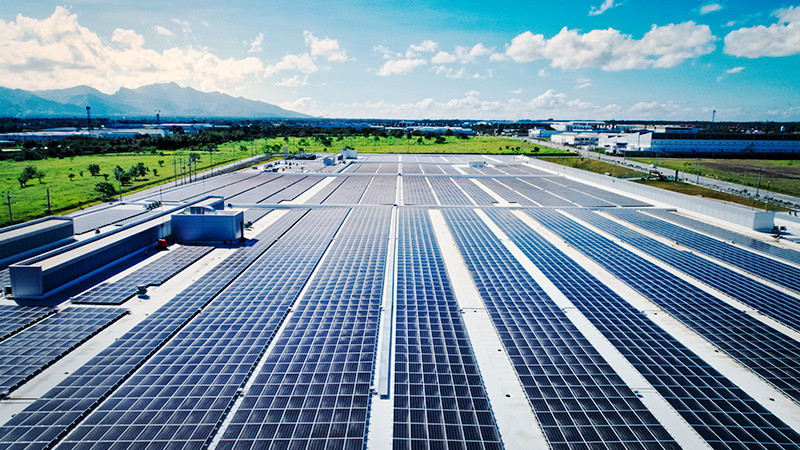
Tackling climate change
Climate change is the biggest environmental challenge facing society and our business. The effects of climate change, such as global warming and changing weather patterns, could have serious implications for our supply chain - given that our products are mainly agriculture-based - and also for our own operations.
We are committed to tackling this issue and are reducing Greenhouse Gas (GHG) emissions across our entire value chain to support global action on climate change, with the longer-term aim of achieving Net-Zero GHG emissions from our operations.
The JT Group supports the Paris Agreement to limit global warming to well below 2°C. Our statement on the Paris Agreement can be found here.
Task Force on Climate-related Financial Disclosures
The potential for financial impact associated with climate change is now well known, and concern is growing about its mid- to long-term impact on business operations and financial market stability. We officially endorsed the recommendations of The Task Force on Climate-related Financial Disclosures (TCFD) in December 2020.
A key aspect of the TCFD recommendations relates to the identification, assessment and management of climate-related risks and their integration into overall risk management.
In line with the expectations of the TCFD, we conducted climate scenario analyses of long-term business risks based on several scenarios.
Governance
Climate-related issues are of strategic importance to our business. Through our business-wide enterprise risk management process, we have identified climate-related risk as one of our enterprise-level risks for our tobacco business, which also needs to be considered in local risk inventories and assessment processes. Board oversight is critical and climate-related issues, especially those that may have impacts on business strategy, are brought up in quarterly Board-level meetings.
Our corporate governance system can be found here.
Strategy
Through climate scenario analysis, we identified two main risks: potential cost increases due to governments raising carbon taxes to further reduce GHG emissions and the impact on tobacco leaf growing due to changes in environmental conditions. Our plan is to mitigate these risks by continuing to implement climate-related initiatives across our value chain and address areas for improvement.
See the JT website for general information on environmental initiatives.
Risk Management
We consider climate-related risks and identify risk mitigation and management approaches through our Enterprise Risk Management (ERM) process. We also include these risks in local risk inventories, assessment processes, and action plans, which are partly based on our ongoing country-level climate scenario analyses. We will compare business-wide risks from local assessments and identify the most critical ones.
Metrics and Targets
We have set a target to reduce GHG emissions from our own operations by 47% (2030 versus 2019). We have also set a longer-term GHG emissions reduction target, as well as targets for renewable electricity, backed by our Group-wide climate scenario analysis.
Read more on Environment, Environmental data / External verification and Data calculation / Consolidation methods.
Details of Climate Scenario Analysis
We are aiming to achieve net-zero in line with the 1.5°C target and are examining various risk factors that may have significant financial and strategic implications for our business over short-term (0-5 years), medium-term (5-10 years), and long-term (10-30 years) timeframes. We utilized the IEA NZE2050 climate change scenarios by the International Energy Agency (IEA) for the assessment of transition risks, and scenarios based on typical concentration pathways outlined by the Intergovernmental Panel on Climate Change (IPCC), such as Representative Concentration Pathways (RCP2.6, RCP4.5 and RCP8.5) for physical risks.
Please refer to the following for the results of our analysis, which focused on extreme cases of temperature increase.
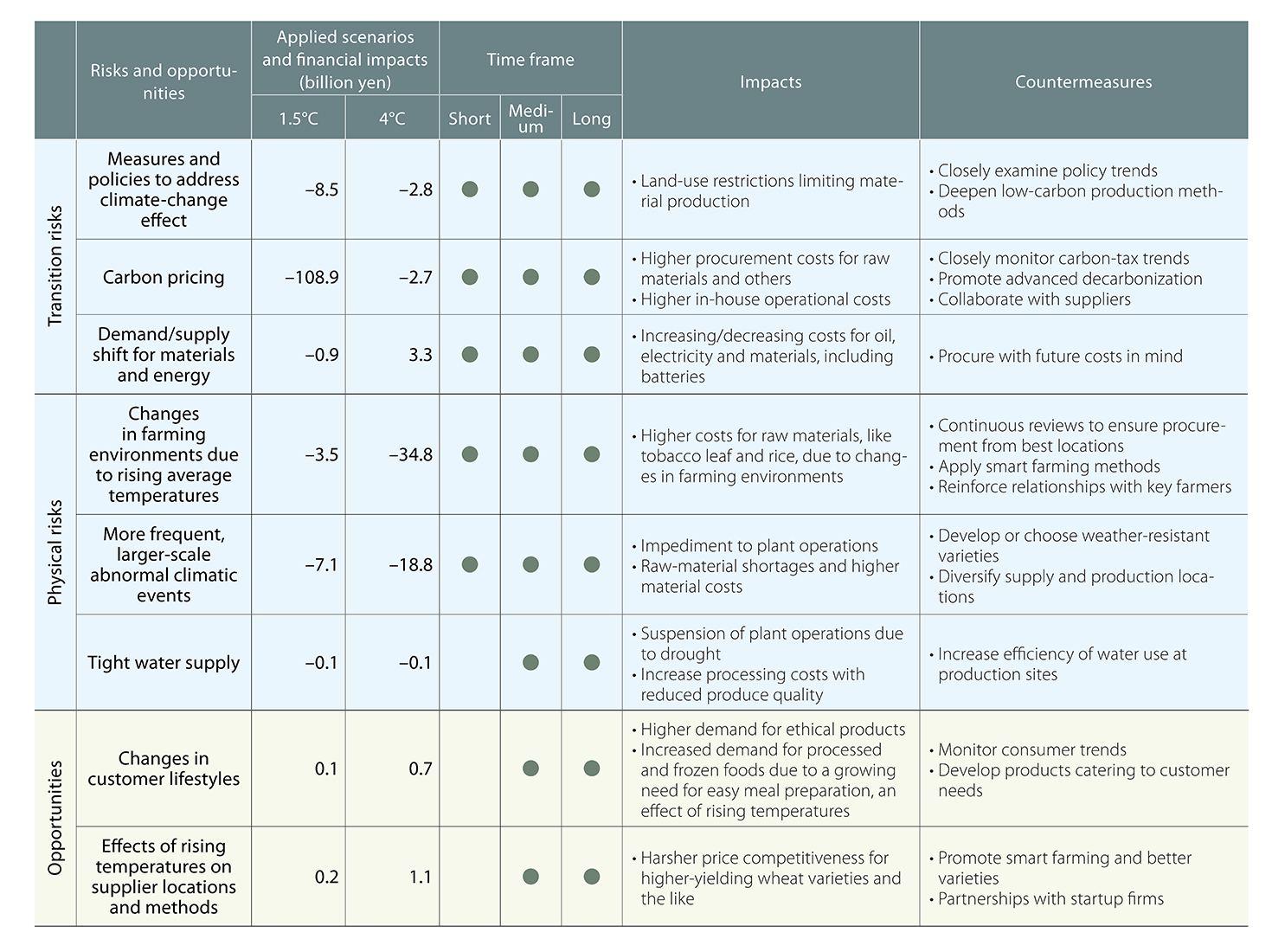
Country-level climate scenario analyses
To further understand climate-related issues and potential risks at a more granular level, we have carried out a program of country-level climate scenario analyses in our tobacco business.
From 2020-2022, we completed climate scenario analyses for eleven countries. We prioritized countries where our business includes tobacco leaf sourcing, manufacturing and markets. We used consistent risk modeling and global warming scenarios across all four years.
We assessed potential exposure and vulnerability to climate-related issues for tobacco leaf sourcing, processing, manufacturing and markets using the following indicators: river flooding, sea level rise, heat stress, rainfall variability, water stress, drought, hurricanes, extreme rainfall and frost. We assessed potential exposure using climate modeling based on scientific research and literature, and assessed vulnerability through interviews with local employees. For our analysis, we used three warming projections called Representative Concentration Pathways: RCP2.6, RCP4.5 and RCP8.5.
Emissions reduction / Renewable energy
We are expanding our sustainability ambitions across the entire value chain and accelerating our efforts to reduce GHG emissions. To date, this has been through a combination of energy and emissions reduction initiatives, increasing the proportion of energy we use that comes from renewable sources and production impacts. Going forward, the main programs projected to achieve the target relate to further improvements in energy efficiency, renewable energy, and vehicle fuel type and efficiency.
As part of our efforts to meet our energy and emissions target, we will increase the proportion of renewable electricity among the forms of energy we use to 50% by 2030, in support of our goal of reaching 100% by 2050. In our tobacco business, we are aiming for 50% by 2025 and 100% by 2040.
In our direct operations, this renewable electricity target will be achieved through on-site generation and sourcing of third-party renewable energy.
To achieve our goals, we will continue introducing renewable energy sources at our operations and investing to raise the ratio of electricity derived from renewables among the forms of energy we use. To accelerate reduction of GHG emissions, we are making use of options available from utility firms to use all or part of the renewable energy they offer, green energy certificates for renewables from third parties, and similar purchasing agreements. See our road map to achieving Net-Zero GHG emissions.
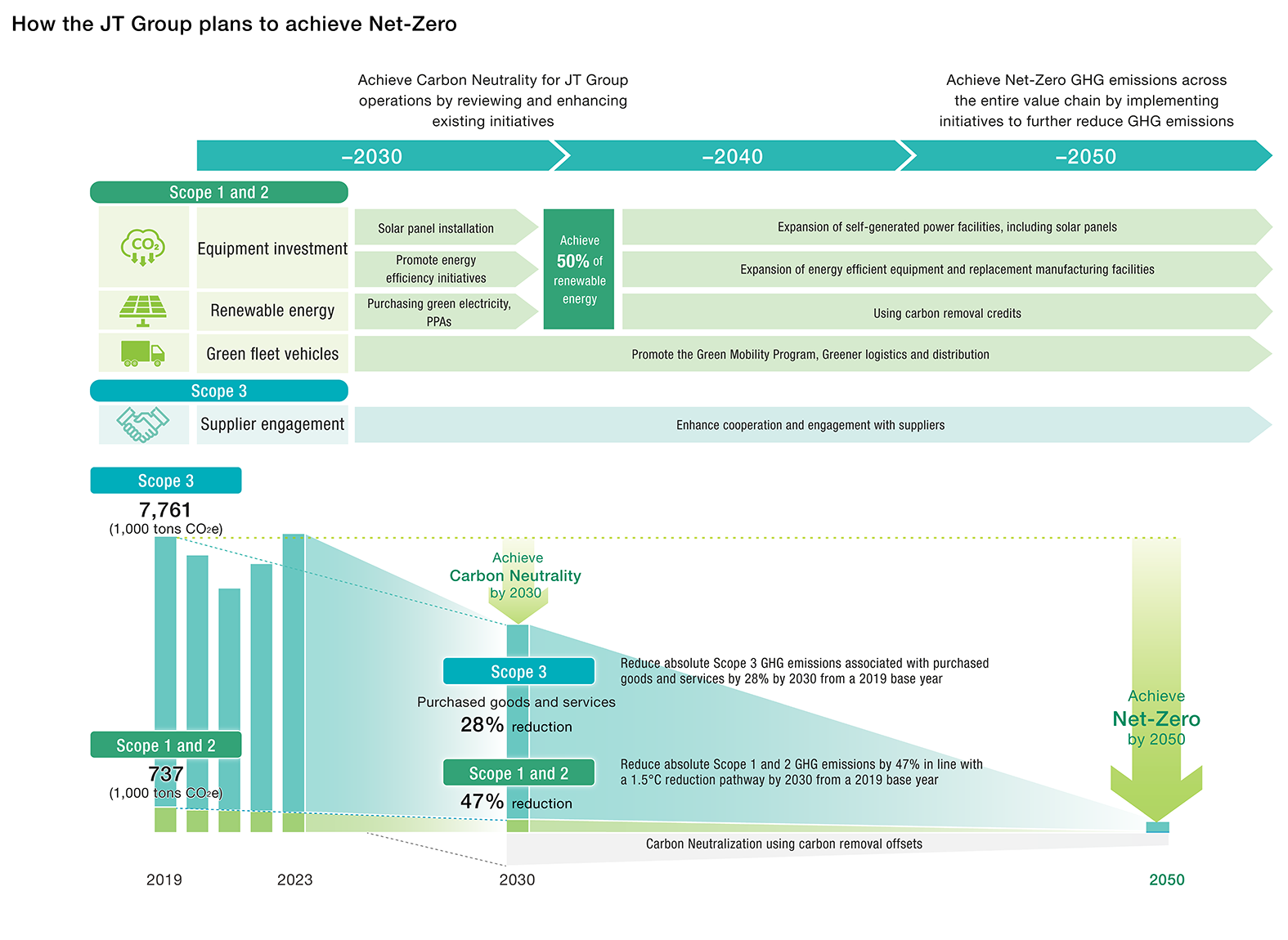
Progress toward quantitative targets
By the end of 2023, 33% of the electricity used in our tobacco business came from renewable sources (either purchased or generated on-site), accounting for 26% of the electricity used Group-wide in 2023. Moving forward, we have plans in place to further increase the proportion of renewable energy among the forms of energy we use.
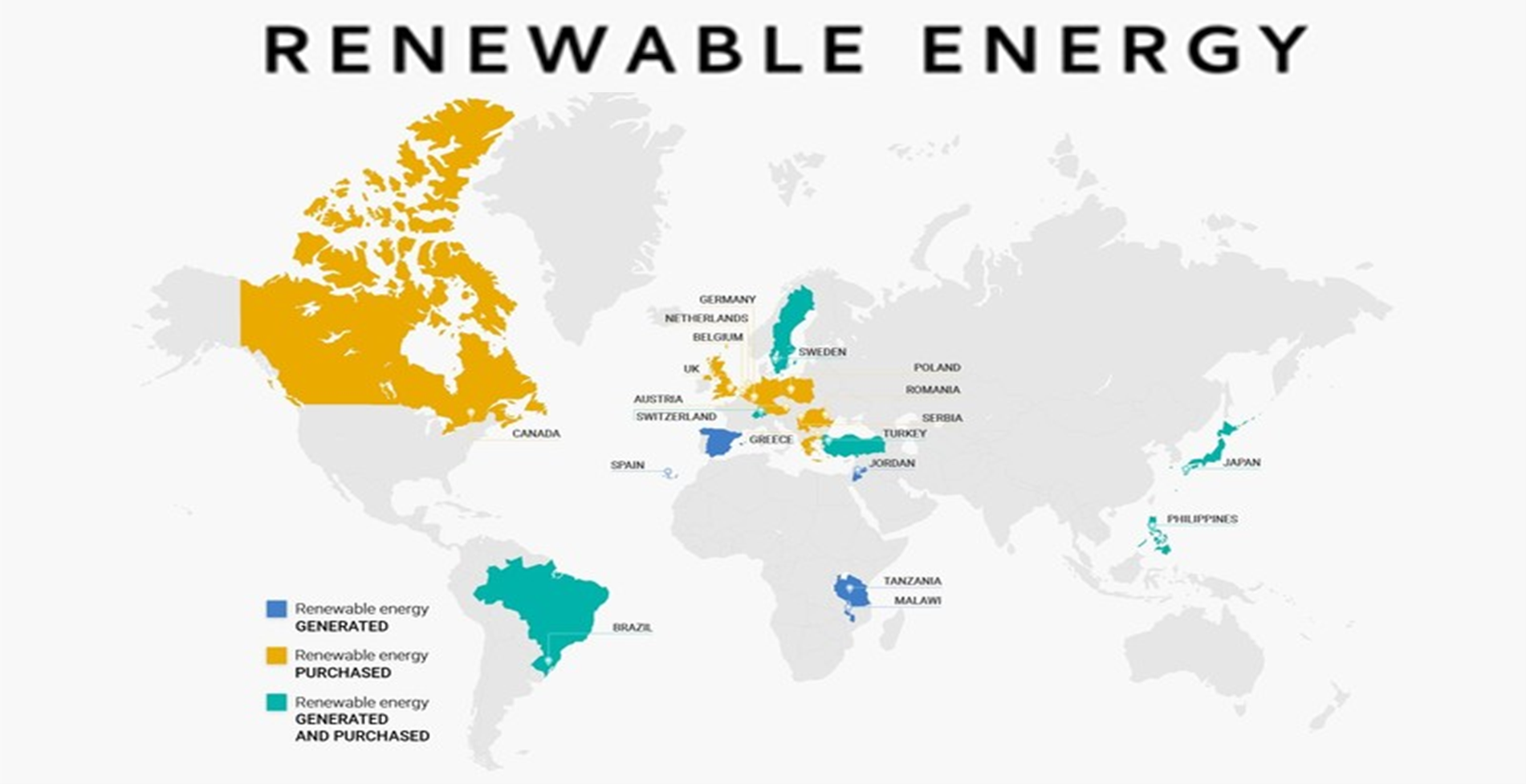
Between 2015 and 2023, JT Group tobacco-related plants implemented 274 projects to reduce energy consumption efficiently with low investment. These have reduced GHG emissions by over 7,000 tonnes, representing cost savings of over US$2.3 million, with recoupment averaging three months.
Vehicle emissions are another important consideration for us, and we encourage all of our locations to select alternative, more environmentally friendly fleet vehicles and change the way in which travel is planned, improve the ways in which employees drive or commute, etc. Within our tobacco business, we have launched our Green Mobility Program, designed to reduce emissions associated with our fleet.
GHG emissions in our supply chain
As part of the JT Group Sustainability Targets, we are committed to reducing GHG emissions associated with our supply chain. We recently updated our absolute Scope 3 GHG emissions targets to reducing our GHG emissions associated with purchased goods and services by 28% by 2030 (compared to 2019) and achieving Net-Zero GHG emissions for our entire value chain by 2050.
In Japan, we have a long-standing relationship with tobacco growers, which brings benefits to our suppliers, our business, and our planet. Working closely with tobacco leaf growers and our machinery supplier, we have developed an innovative drying machine which improves fuel efficiency in the tobacco curing process, reducing both the use of non-renewables and GHG emissions. In addition, the new machines help growers to save costs and improve quality, directly impacting our business and improving the environmental impact associated with our tobacco value chain. By the end of 2023, our tobacco leaf growers were using a total of 825 of these drying machines across Japan. We plan to further advance the program by improving the efficiency of the curing system to make the process even more sustainable and environmentally friendly.
We continue focusing our efforts on improving curing efficiency, through barn furnace upgrades and new heat exchange designs. These not only optimize tobacco leaf quality, but also reduce wood fuel consumption. In addition, we are addressing the production of wood resources required for tobacco curing through dedicated agroforestry programs and tree-growing initiatives in Tanzania and Zambia, for instance.
Please see other detailed efforts on theJT International sustainability website.
Progress toward quantitative targets
In 2023, GHG emissions related to purchased raw materials and services increased by 3% compared with 2019. The increase was mainly due to temporary procurement increases from Tanzania and other nations that will require more time to shift to renewable energy sources in the leaf-drying process, as a result of business scale expansion and climatic influences.
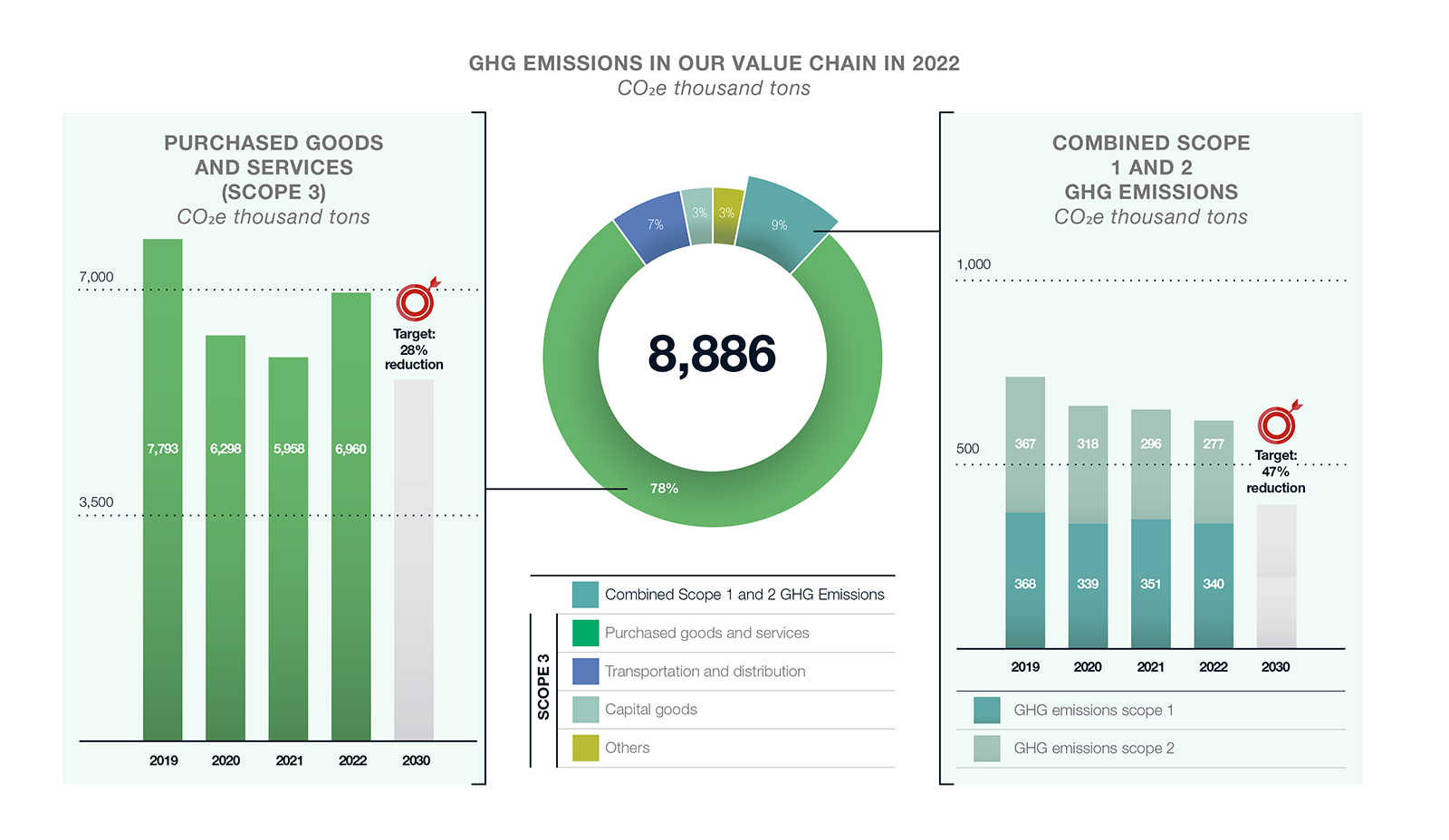

Science Based Targets
GHG emissions reduction targets for 2030 from our operations have been validated by the Science Based Targets Initiative (SBTi) as being in line with the 1.5℃ global warming scenario. In June 2024, we submitted a commitment letter to establish science-based GHG emission reduction targets within two years for achieving net-zero emissions across our entire value chain.
Protecting water
In the JT Group Sustainability Targets, we commit to supporting global water stewardship by reducing our water use and encouraging water risk management in our supply chain. We have set a target to reduce our tobacco business-associated water use by 33% relative to 2019 levels by 2030.
Societal demand for water is increasing globally and water-related issues such as availability, quality, flooding, drought, or regulatory changes can have a major impact on society and our business.
Our tobacco and food manufacturing activities all use water. However, for our main operation, the tobacco business, the water that is required for tobacco crops comes predominantly from rainfall, while tobacco processing and manufacturing are not water-intensive.
As part of our approach to good water stewardship, we committed to carrying out water risk assessments at 100% of our factories. In 2020, we completed the first risk assessments at all of our factories, and we are now working on a program of reassessments. Our water risk assessments consider water availability and quality, changing legislation, natural disasters such as floods and drought, and future water stress. From the assessments, we develop action plans to reduce risk and improve overall water management and security.
We will continually support global water stewardship by reducing our water usage and encouraging water risk management throughout our supply chain.
Please see other detailed efforts for water stewardship on theJT International sustainability website.
Progress toward quantitative targets
Through our initiative for efficient water use, we reduced water use associated with our tobacco business by 26% from 2015 to 2023, well ahead of our target of 15% by 2030. Encouraged by this, we have set even more ambitious goals in the JT Group Sustainability Targets, with 2019 as the baseline year.

Biodiversity
Responsible management of biodiversity is important for the JT Group. Our focus is on conservation of biodiversity during tobacco growing, where our biggest impact is. One of the JT Group Principles in Tobacco Leaf Production is to reduce environmental impact and ensure efficient use of natural resources while striving to conserve biodiversity. Biodiversity is also included as a focus area in the Tobacco Leaf Sustainability Framework. We endorsed the Declaration of Biodiversity by Keidanren, which is an ambitious action guideline that summarizes specific biodiversity-related activities in Japan.
Please see the JT Group Biodiversity Statement for more on our commitment and ambitions.
Biodiversity risk assessment
In 2022, we conducted an initial risk assessment of our impact and dependency on biodiversity for our tobacco business, with reference to TNFD v0.3 and the International Union for Conservation of Nature’s (IUCN) guidelines. The scope of the assessment covers our own operations, upstream activities, and downstream activities.
When carrying out the impact assessment, we firstly broke down our business activities into raw material sourcing, manufacturing, and disposal and evaluated the impact of each activity. On top of that, since biodiversity is closely related to the natural resources of specific regions or countries, we analyzed the main countries in which we operate regarding scope and severity, and calculated qualitative impact scores accordingly. This has helped us to identify the locations where our business is assumed to have a high impact on biodiversity. During the assessment, we referred to data from ENCORE*, the National Biodiversity Index (NBI), and the Environmental Performance Index (EPI).
Regarding dependency, we used the same methodology utilized to assess our impact and have identified areas and locations where our business has high levels of dependency on biodiversity.
Through these impact and dependency analyses, terrestrial ecosystem use, water pollutants and soil pollutants were identified as potential impacts on biodiversity in the tobacco supply chain. Regarding dependency, the prevention of flood and storm, land stabilization, water supply are possible areas with high dependency on ecosystem services.
Looking ahead, we will further carry out both qualitative and quantitative risk assessments covering the whole Group step by step, with the aim to define our main focus areas, objectives, plans and targets to address the issues. Our second round of Group-wide risk assessment is completed in September 2023.
*Natural Capital Finance Alliance (Global Canopy, UNEP FI, and UNEP-WCMC) (2022). ENCORE: Exploring Natural Capital Opportunities, Risks and Exposure. [On-line], [December, 2022], Cambridge, UK: the Natural Capital Finance Alliance. Available at: https://encore.naturalcapital.finance. DOI: https://doi.org/10.34892/dz3x-y059.
Biodiversity conservation actions
When moving forward with our actions based on risk assessments, we are embracing the Science-Based Targets for Nature (SBTN) guidance on the mitigation hierarchy following the AR3T framework. The following initiatives are examples of our approaches:
Avoid
We are working to replace Highly Hazardous Pesticides (HHPs) with safer, more environmentally friendly options across the Company.
In January 2022, we updated our internal standards for Crop Protection Agent (CPA) residue. HHP limits have now been applied to all processed tobacco from crops transplanted in 2022. If, through our analysis, we detect that the residue level of HHP Criterion 1 pesticides exceeds the LoQ, we do not purchase the tobacco. We formally communicated this to all our tobacco suppliers in February 2021.
In addition, we made it clear that we expect them to avoid environmental contamination and, more importantly, to protect people and animals from exposure to hazardous CPAs. We stressed that using less hazardous CPAs is as critical as wearing the correct personal protective equipment.
Reduce
In 2022, we introduced a new sustainability governance model with a focus on product stewardship, circularity and waste. It aims to manage the safety and environmental and social impacts of our products and their packaging at all stages of their life cycle, in order to avoid waste through product circularity or reduce it by operating an effective waste management system.
We will reduce our packaging (including plastic) and ensure that the remaining is 88% reusable or recyclable by 2025, and 100% by 2030. Our tobacco business will reduce packaging and achieve 85% recyclability by 2025, rising to 100% by 2030. In total, recycled content will account for 20% of our tobacco business packaging by 2025.
Regenerate
In Zambia, we are taking proactive approaches to biodiversity regeneration and forest conservation. The Shishamba Forest Livelihoods Project in Zambia is an initiative for the sustainable management of Miombo woodlands. It includes, among other things, the promotion of woodland conservation practices such as fire management and assisted natural regeneration. Local communities are empowered to use and manage forest resources responsibly and sustainably.
Restore
We are partnering with the Wildlife Research and Environmental Education Society and the National Bank for Economic and Social Development (BNDES) to restore over 300 hectares of permanently protected areas in Brazil with the participation of our contracted growers. This area includes parts of a national nature reserve as well as land owned by tobacco growers.
The restoration work started in 2018, when we replaced 35 hectares of pine trees in the Pirai do Sul National Forest with native species to help restore the natural landscape. We also trained 33 local college students in ecological restoration.
By planting some 140,000 seedlings of native species and installing 200,000 meters of protective fences, more than 195 hectares have been restored on 200 small farms in Permanent Preservation Areas, and we have only 6 hectares left before we reach our restoration target.
We are also restoring 75 hectares of the Meia Lua Nature Reserve, in the municipality of Ponta Grossa. The project was audited and approved by the BNDES, the funding partner, in November 2022 and completed in May 2023.
Transform
We have continued a partnership with the LIFE Institute, an international non-profit standard-setting organization, since 2017 to measure and improve our impacts on biodiversity.
The LIFE Methodology for Business and Biodiversity has helped our tobacco leaf business in Brazil to enhance its sustainability performance and deepen its understanding of and commitment to biodiversity. An important benefit of the partnership with LIFE is reflected in information management. Organization and standardization of environmental data make investment decisions based on evidence possible, allowing investments to bring greater environmental benefits and lowering risks to companies.
Our partnership with LIFE, together with other companies, led to the launch of the LIFE Coalition for Business and Biodiversity, a group of leading companies which share the ambition of scaling up biodiversity conservation at a global level through LIFE solutions. This group provides a great opportunity to exchange best practice experiences to mitigate impacts related to the methodology's indicators: carbon footprint, water use, waste generation, land use, and energy use, all leading to biodiversity conservation.
Read more on Supply Chains and see other detailed efforts for biodiversity on the JT International sustainability website.
Each of the JT Group businesses will perform assessments to evaluate their impact and dependency on the ecosystem, including biodiversity aspects as set in the JT Group Sustainability Targets. Assessments for the tobacco business will be performed by 2024, and for the pharmaceutical and processed food businesses by 2025.
Forestry
Ensuring a sustainable wood supply and contributing to conserving and rehabilitating forests are key objectives set out in the JT Group Sustainability Targets. One of our targets is to achieve net-zero deforestation of managed natural forests throughout the entire tobacco business supply chain by 2030. Our focus is to establish and monitor woodlots with higher productivity and usability, securing a sufficient, renewable supply of wood for tobacco production while also reducing wood consumption through improved curing efficiency. Due to the importance of forestry conservation for our business and society as a whole, we are currently reviewing our environment plan to update our targets.

Progress toward quantitative targets
Improvements in tree planting and wood production
Based on our 2023 tree-planting activities in Tanzania, Zambia, and Brazil, we estimate 103% renewable wood supply in crop year 2030, based on actual tree-planting data captured with the Agroforestry App in CY2023 (November 2022–February 2023).
Improvements in tree seedling production
Improved adoption of our Minimum Forestry Standards (MFS) has already shown results in enhanced tree seedling quality and uniformity. Quality tree seedlings are the basis for successful woodlot establishment and optimized tree growth potential.
Please see other detailed efforts related to forestry on theJT International sustainability website.
Waste Reduction
From a societal and stakeholder perspective, concern is increasing surrounding waste, particularly plastic waste. From a business perspective, all waste has a direct cost (handling and disposal) and an indirect cost (resource and processing costs).
We consider waste impacts at each stage of our operations from receiving materials and services to post-consumer disposal of our products and packaging. That’s why waste management is a key component of the JT Group Sustainability Targets. Across the JT Group, we apply a “reduce, reuse, recycle” approach. As reducing waste helps to conserve resources, we have also set targets in that regard, which in turn helps to minimize our environmental impact and cut business costs.
Progress toward quantitative targets
Based on 2023 results, we have reduced waste associated with our tobacco business by 20% compared to 2015, successfully achieving our waste reduction target of 20% by 2030 ahead of schedule. This was driven predominantly by waste reduction initiatives (e.g., production yield improvement) and waste reuse programs (e.g., reuse of tobacco cases).
We will aim to further reduce our environmental impact by realizing the targets set in the JT Group Sustainability Targets, which focus on resource recycling.
Read more on Product stewardship, circularity and waste.
Designing for circularity - Packaging, products and devices
The JT Group has set a target to reduce its packaging (including plastic) and ensure that the remaining is 88% reusable or recyclable by 2025, rising to 100% by 2030.
Please see other detailed efforts on the JT International sustainability website.
Sustainable agriculture
As set in the JT Group Sustainability Targets, the JT Group's directly contracted tobacco leaf growers will eliminate the use of Criterion 1 HHPs by 2024, and all HHPs by 2040. By 2030, 100% of our directly contracted growers will have adopted our Good Agricultural Practices (GAP) Protocol.
For more information, please visit the JT International sustainability website.
Case studies
Sustainability is deeply embedded in our operations. We work hard to minimize our environmental impact by focusing on energy efficiency, GHG emission reduction, water efficiency, and waste reduction. Many programs and initiatives are already in place, both globally and locally. These include everything from the way we source raw materials to the way we ship finished products. Read more about our local and global activities:
In our Japanese business operations (Japanese website)
In our tobacco business